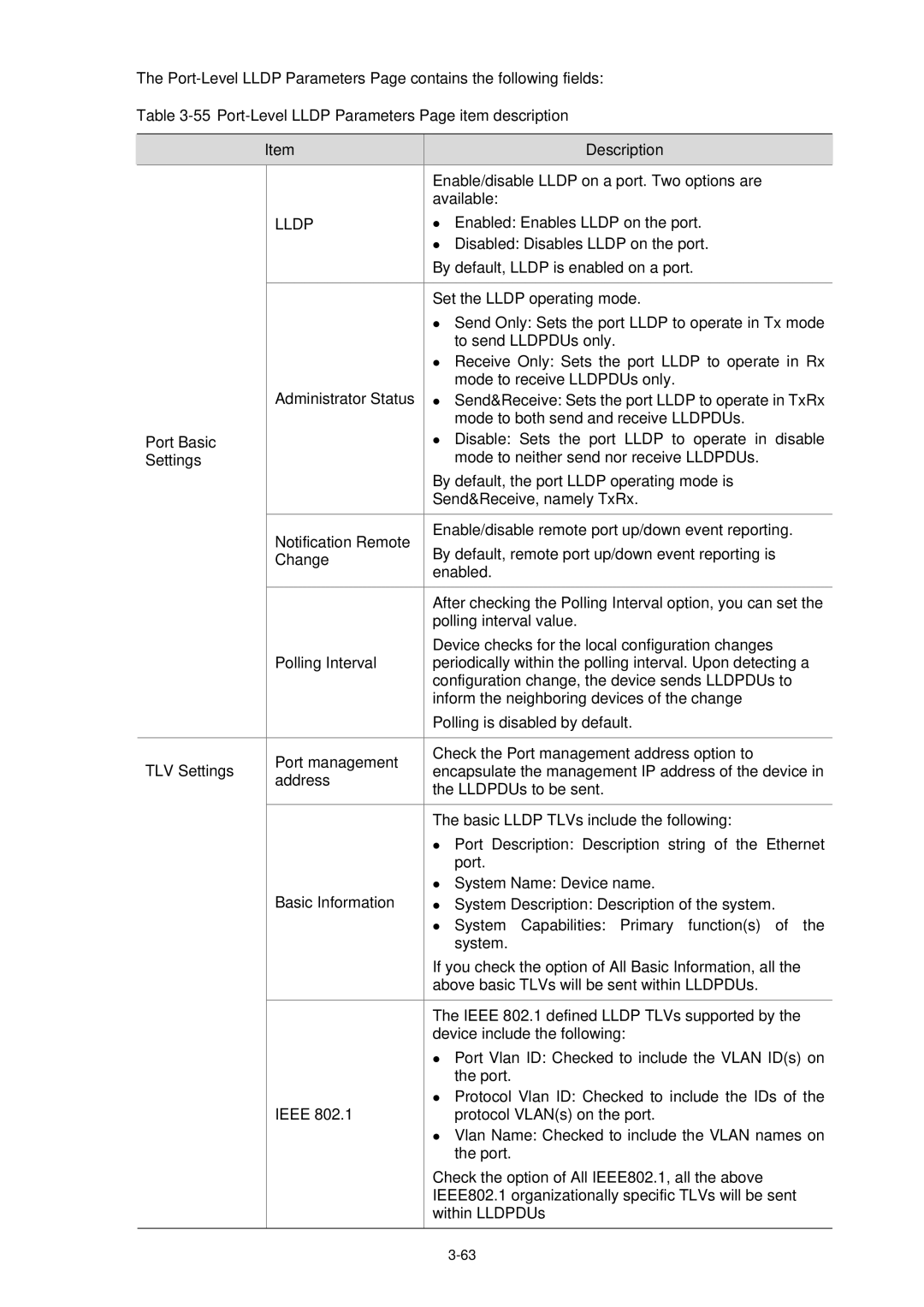The
Table
|
|
| Item |
|
| Description | |
|
|
|
|
|
| Enable/disable LLDP on a port. Two options are | |
|
|
|
|
|
| available: | |
|
|
|
| LLDP |
| z Enabled: Enables LLDP on the port. | |
|
|
|
|
|
| z Disabled: Disables LLDP on the port. | |
|
|
|
|
|
| By default, LLDP is enabled on a port. | |
|
|
|
|
|
|
| |
|
|
|
|
|
| Set the LLDP operating mode. | |
|
|
|
|
|
| z Send Only: Sets the port LLDP to operate in Tx mode | |
|
|
|
|
|
|
| to send LLDPDUs only. |
|
|
|
|
|
| z Receive Only: Sets the port LLDP to operate in Rx | |
|
|
|
| Administrator Status |
|
| mode to receive LLDPDUs only. |
|
|
|
|
| z Send&Receive: Sets the port LLDP to operate in TxRx | ||
|
|
|
|
|
|
| mode to both send and receive LLDPDUs. |
|
| Port Basic |
|
|
| z | Disable: Sets the port LLDP to operate in disable |
|
| Settings |
|
|
|
| mode to neither send nor receive LLDPDUs. |
|
|
|
|
|
| By default, the port LLDP operating mode is | |
|
|
|
|
|
| Send&Receive, namely TxRx. | |
|
|
|
|
|
|
| |
|
|
|
| Notification Remote |
| Enable/disable remote port up/down event reporting. | |
|
|
|
|
| By default, remote port up/down event reporting is | ||
|
|
|
| Change |
| ||
|
|
|
|
| enabled. | ||
|
|
|
|
|
| ||
|
|
|
|
|
|
| |
|
|
|
|
|
| After checking the Polling Interval option, you can set the | |
|
|
|
|
|
| polling interval value. | |
|
|
|
|
|
| Device checks for the local configuration changes | |
|
|
|
| Polling Interval |
| periodically within the polling interval. Upon detecting a | |
|
|
|
|
|
| configuration change, the device sends LLDPDUs to | |
|
|
|
|
|
| inform the neighboring devices of the change | |
|
|
|
|
|
| Polling is disabled by default. | |
|
|
|
|
|
|
| |
|
| TLV Settings |
| Port management |
| Check the Port management address option to | |
|
|
|
| encapsulate the management IP address of the device in | |||
|
|
| address |
| |||
|
|
|
|
| the LLDPDUs to be sent. | ||
|
|
|
|
|
| ||
|
|
|
|
|
|
| |
|
|
|
|
|
| The basic LLDP TLVs include the following: | |
|
|
|
|
|
| z | Port Description: Description string of the Ethernet |
|
|
|
|
|
|
| port. |
|
|
|
| Basic Information |
| z System Name: Device name. | |
|
|
|
|
| z System Description: Description of the system. | ||
|
|
|
|
|
| z System Capabilities: Primary function(s) of the | |
|
|
|
|
|
|
| system. |
|
|
|
|
|
| If you check the option of All Basic Information, all the | |
|
|
|
|
|
| above basic TLVs will be sent within LLDPDUs. | |
|
|
|
|
|
|
| |
|
|
|
|
|
| The IEEE 802.1 defined LLDP TLVs supported by the | |
|
|
|
|
|
| device include the following: | |
|
|
|
|
|
| z Port Vlan ID: Checked to include the VLAN ID(s) on | |
|
|
|
|
|
|
| the port. |
|
|
|
| IEEE 802.1 |
| z Protocol Vlan ID: Checked to include the IDs of the | |
|
|
|
|
|
| protocol VLAN(s) on the port. | |
|
|
|
|
|
| z Vlan Name: Checked to include the VLAN names on | |
|
|
|
|
|
|
| the port. |
|
|
|
|
|
| Check the option of All IEEE802.1, all the above | |
|
|
|
|
|
| IEEE802.1 organizationally specific TLVs will be sent | |
|
|
|
|
|
| within LLDPDUs | |
|
|
|
|
|
|
| |
